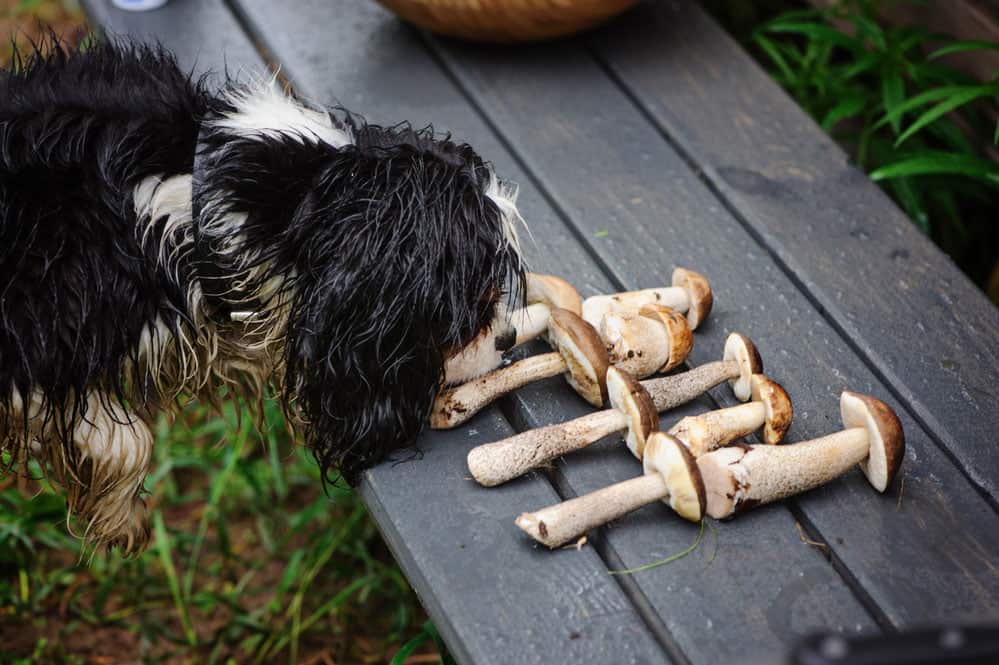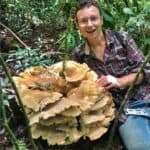Table of Contents
Dogs will try to eat almost ANYTHING. No matter how disgusting it is, they’ll put it in their mouths. This is their way to explore the world. But what happens when your dog eats a mushroom?
Well, it DEPENDS on the mushroom.
Some mushrooms are poisonous to dogs, while others are not. Generally, the same mushrooms that are poisonous to us are poisonous to dogs. Vice versa, mushrooms that are edible by us can also be eaten by our 4 legged canine friends. While serious illness or death from mushrooms in dogs is rare, it DOES happen.
What to do if your Dog has eaten a Wild Mushroom
Let’s say you’ve spotted something strange in your dog’s mouth. Before you know it, it’s eaten a wild mushroom! What do you do?
- Remain calm. It’s unlikely your dog has eaten a deadly poisonous mushroom. Regardless, assume it has until you’ve confirmed the safety of your pet.
- Look and Document Evidence of the Mushroom. Before you leave the scene, look for pieces of the mushroom. If you find any, take a picture of them from every possible angle. If possible, take the pieces with you. Mushrooms often fruit in patches, so search the area for more of the same species. Take pictures and a specimen if possible. This will help with identification.
- Head To The Veterinarian. It’s better to be safe than sorry. If you arrive soon enough, the vet may be able to induce vomiting. If not, they may be able to distinguish symptoms of mushroom poisoning.
- Try to Identify the Mushroom. Below we provide a list of common poisonous mushrooms. Consult this list. You can also google search “Poisonous Mushrooms of ________” filling it in with your region (country, state, country, etc.). Facebook groups can also help identify mushrooms via photos. Click here for the group “Poisons Help; Emergency Identification for Mushrooms and Plants”. There is also a list of volunteers who will help identify potentially poisonous mushrooms. Also, search for a local group by searching for your region with the keyword mushroom. You can ask if there are any poisonous mushroom fruiting in your area at the moment if you have no pictures.
- Watch for Symptoms, Wait for Identification, and Follow the Guidance of Your Vet. Your vet will know best as they may already have experience with poisonings in your area.
Poisonous Mushrooms commonly consumed by Dogs
| Overview | Description |
| Common Name: Death Cap Latin Name: Amanita phalloides Size: Large Habitat: Woodland/Forest Toxicity: Potentially Deadly | These mushrooms are large and typically occur in association with oak. They have a tannish/yellow cap that may have a single white splotch on the top. The stem is white with a ring and a fleshy bulbous base. |
| Common Name: Destroying Angel Latin Name: Amanita virosa (or A. ocreata) Size: Large Habitat: Woodland/Forest Toxicity: Potentially Deadly | These appear just like the Death Cap described above but are completely white. |
| Common Name: Fly Agaric Latin Name: Amanita muscaria Size: Large Habitat: Woodland/Forest Toxicity: Hallucinogenic | Easily recognized by a brightly colored cap that ranges in color from yellow to red. Cap also usually has white splotches. Has a white stem with a ring and a bulbous base. |
| Common Name: Magic Mushrooms Latin Name: Psilocybe cubensis Size: Large Habitat: Pasture Toxicity: Hallucinogenic | These grow in cow pastures in subtropical to tropical climates. They grow directly from fresh cow manure. They are grey and may bruise blue when damaged. Gills turn a dark color when mature. |
| Common Name: Jack O’ Lantern Latin Name: Omphalotus olearius Size: Large Habitat: Rotting Wood Toxicity: Induces Severe Sickness | These are often found growing on rotten wood in forests. They grow in patches and are orange in color. |
| Common Name: Skull Cap Latin Name: Galerina marginata Size: Small Habitat: Rotting Wood Toxicity: Potentially Deadly | Galerina mushrooms are small and brittle. They usually grow on decomposing logs or wood chips. The cap is brown and the stem is white with a distinct ring. |
| Common Name: Deadly Dapperling Latin Name: Lepiota brunneoincarnata Size: Medium Habitat: Grass Fields Toxicity: Potentially Deadly | Often occurs in grass fields and parks. It is mostly white but the cap has concentric brown scales. Stems can be pinkish/brown. |
| Common Name: Morels/False Morels Latin Name: Morchella sp. Gyromitra sp. Helvella sp. Size: Small/Medium Habitat: Landscaping/Disturbed Forests Toxicity: Sickening | These are irregularly shaped mushrooms that have a brain-like texture. They can range in color from red to blond to black. They typically have a strong spermatic odor. While some are edible cooked, they are all poisonous when consumed raw. |
| Common Name: Web Caps Latin Name: Cortinarius sp. Size: Medium/Large Habitat: Forests and Woodlands Toxicity: Possibly Deadly | This is a group of mushrooms commonly found in forests. They are often purple but can also be green, white, brown, or a variety of colors. Their distinct feature is web-like silk that covers the gills. Their spores are also rusty brown and will coat the stem when they mature. |
| Note: This is only a partial list of Mushrooms that are Poisonous to Dogs. | Size Definitions: Small: <3″ Medium: 4-6″ Large: >6″ |
Symptoms of Mushroom Poisoning in Dogs
Symptoms usually begin anywhere from 15 minutes to an hour after ingestion. If there are no symptoms after this time, there is still reason to take precautions and consult your Vet.
- Unusual Behavior
- Excessive Salivation
- Tremors
- Seizures
- Vomiting
- Drunkenness
- Diarrhea
- Weakness
- Eye Watering
Other Emergency Resources
Can Dogs eat Store bought Mushrooms?
If you’re wondering whether dogs can eat the same mushroom you eat, they can! They can be a healthy addition to a dog’s diet when properly prepared. Keep in mind that we usually cook mushrooms with ingredients that are not healthy for dogs!
Mushrooms that are safe for dogs include Shiitake, Oysters, Button Mushrooms, and Portabello. DO NOT feed your dog raw mushrooms as this is harmful to their digestive system.
Can you give Dogs Medicinal Mushrooms?
Studies on medicinal mushrooms have not been conducted on dogs. For this reason, we DO NOT recommend it. However, many medicinal mushroom studies occur on smaller animals like mice. So some are likely safe.
If you do consider this, make sure you give an adequate dose based on body weight.

